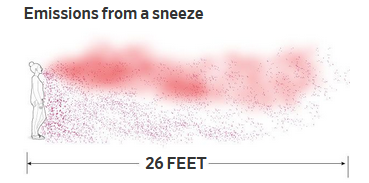CDC Re-Releases Guidance Claiming COVID-19 ‘Airborne’ Transmission Is Possible, But Less Common
Tyler Durden
Mon, 10/05/2020 – 14:40
As CDC head Dr. Robert Redfield told Congress last week, the CDC has re-released its “updated” guidance on coronavirus transmission via “aerosols” – tiny particles that, research shows, can infect people over long distances given poor ventilation.
Notably, the updated guidance on the CDC’s website is nearly identical to guidance that it published, then almost immediately pulled, last month.
Though the CDC claims COVID-19 is primarily spread through “close contact” – ie within 6 feet – with an infected person, it is “sometimes” spread via “airborne” transmission – but even these types of infections typically happen at close range.
Here’s the bulk of the revised statement, which can be found here.
- COVID-19 can sometimes be spread by airborne transmissionSome infections can be spread by exposure to virus in small droplets and particles that can linger in the air for minutes to hours. These viruses may be able to infect people who are further than 6 feet away from the person who is infected or after that person has left the space.
- This kind of spread is referred to as airborne transmission and is an important way that infections like tuberculosis, measles, and chicken pox are spread.
- There is evidence that under certain conditions, people with COVID-19 seem to have infected others who were more than 6 feet away.
- These transmissions occurred within enclosed spaces that had inadequate ventilation. Sometimes the infected person was breathing heavily, for example while singing or exercising.
- Under these circumstances, scientists believe that the amount of infectious smaller droplet and particles produced by the people with COVID-19 became concentrated enough to spread the virus to other people. The people who were infected were in the same space during the same time or shortly after the person with COVID-19 had left.
- Available data indicate that it is much more common for the virus that causes COVID-19 to spread through close contact with a person who has COVID-19 than through airborne transmission.
The CDC added that it was “much more common” for the virus to spread via close contact rather than airborne transmission.
With nearly 30 White House staffers laid up with coronavirus, and President Trump sick himself over at Walter Reed, some suspected that the CDC was pushing through a change in defiance of the White House’s wishes.
BREAKING: Last month CDC website said airborne transmission was “possible,” then removed the reference.https://t.co/Nfj18HWBuK
Now it says people can sometimes be infected with the coronavirus through airborne transmission.https://t.co/uTmVSM84Xm
— Aaron Blake (@AaronBlake) October 5, 2020
But readers may recall that it was the WHO, not the administration, which successfully pressured the CDC to retract the prior guidance on aerosols and sub in some more measured language.
Hundreds of scientists from around the world have been pressing WHO to change its guidance on aerosol transmission amid a growing body of research suggesting that aerosols might be a much more common “vector” for infection than previously believed. The WHO, for whatever reason, has refused to change its guidance, and continues to insist that while aerosol infection is one vector, evidence for spread over long distances is scarce, and it’s more likely that these tiny particles can only infect individuals who are within six feet of an infected person, unless ventilation is poor, and/or the individuals are indoors in an environment where heavy breathing, shouting or singing – like a gym or a concert hall – is taking place.
One study even suggested that aerosols could infect people at a range of up to 30 feet.
The new guidance also claims that the likelihood of infection drops sharply once the infected person leaves the area.
The update triggered an outpouring of criticism about the agency’s many flip-flops (of which this is the latest).
The CDC has flip-flopped more in 9 months than John Kerry has in his entire life.
— Weary Traveler (@TravelingWilds) October 5, 2020
Some mockingly lambasted the agency as “the centers for damage control” when it released new guidance saying those without symptoms who may have been exposed to the virus didn’t need to get tested – before retracting it later.
After initially withdrawing the guidance last month, the CDC claimed that it had “accidentally” posted a “draft” of the update, while the final version weakens the language surrounding the prevalence of airborne transmission.
